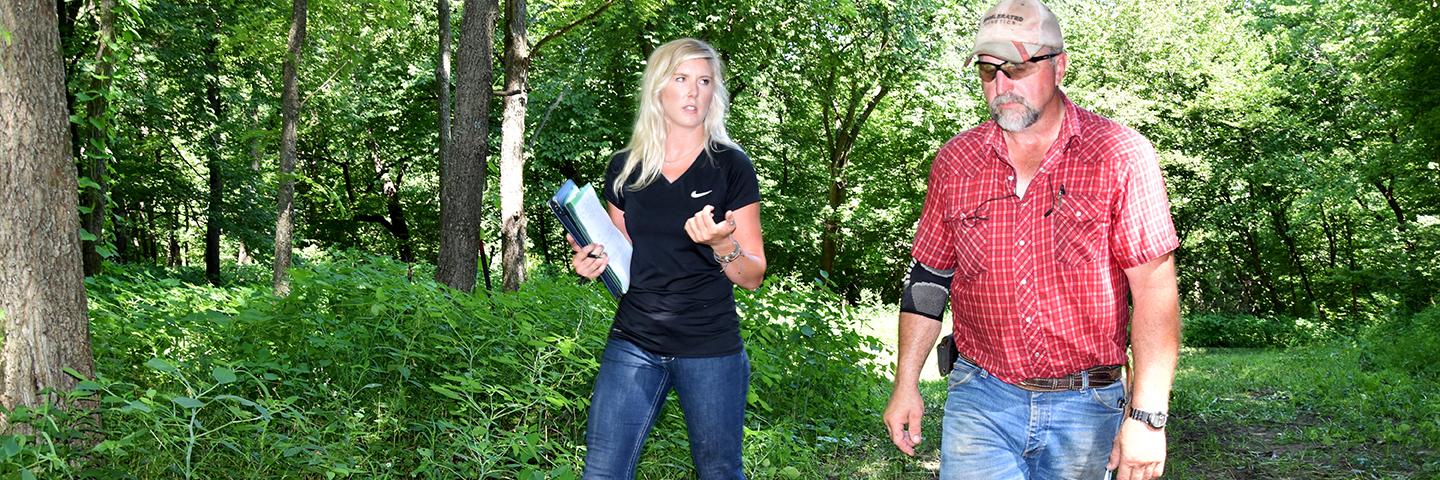Cover Crops Supplement Livestock Feeding for Western Iowa Farmer

Monona County farmer Bo Fox is working with USDA’s Natural Resources Conservation Service (NRCS) to more efficiently graze his 100-head cow/calf herd and to help improve soil health on his farm.
Fox, who farms with his son Jake in western Iowa’s Loess Hills near Turin, is a long-time no-tiller. In the past few years, he has expanded his crop management from just no-tilling corn and soybeans to including crop rotations with small grains, cover crops and livestock grazing of cover crops.
Ryegrass Cover Crop
Fox experimented with cover crops in the past but has recently worked with NRCS for planning and financial assistance to grow a diverse cover crop mix suitable for spring livestock grazing.
In early September 2017, Fox aerial seeded a cover crop seed mix that included ryegrass and radishes into 60 acres of standing corn and soybeans. Ryegrass can be “hit or miss” as an overwintering cover crop. Fox says establishing it early enough – in late summer or early fall – is important for overwintering. “I use ryegrass because of the (low) cost and for the (high amount of) biomass production,” he said. “I would prefer drilling the cover crop after harvest to achieve a better stand, but I like aerial seeding, too, in years we have a late harvest and don’t have time to drill it in.”
In the spring of 2018, Fox grew his cover crop to about waist high before grazing it for three weeks to about a four-inch height. After removing the cattle, he let it grow back to about 18 inches, sprayed it, and then no-till planted corn into it.
In Fall 2018, Fox chopped corn for silage which allowed him time to drill in his cover crop. He also used different cover crop varieties. “We had severe weather issues in 2017 and 2018 where we very much relied on the ryegrass for grazing the cattle,” said Fox.
Fox and his son Jake are both utilizing the USDA’s Environmental Quality Incentives Program (EQIP) to help supplement cover crop expenses. Through EQIP, NRCS is paying Iowa farmers $33.83 to $68.18 per acre for single- or multi-species winter hardy cover crops and $18.74-$33.72 per acre for winter killed cover crops in fiscal year 2019.
Benefits of Cover Crops
Along with providing his livestock an additional grazing source, Fox says cover crops benefit his soils in the following ways:
- Moisture Levels: “Using no-till and cover crops, I have noticed better soil moisture conditions in the hot, dry summer months compared to fields with only no-till.”
- Weed Management: “If you’re using cover crops for weed management, it is critical to allow the cover crop to grow and develop before termination. Ryegrass does a wonderful job on the weeds.”
- Compaction: “Even though we run livestock on our cover crop fields, we still don’t see the compaction issues that we have seen on other fields. I think the cover crops play a major role in that.”
- Fertility: “By using cover crops, I can increase the amount of biological activity and organic matter in the soil faster than no-till alone, which helps improve fertility in the soil.”
Fox says he commends NRCS for doing so much with soil health. “(District Conservationist Jackie Kragel) has been a benefit to our county, with her ideas and promotion,” he said. “NRCS is providing more soil health information to farmers than they ever have before.”
Kragel, who now works for NRCS in Colorado, served as the district conservationist in Monona County for two years.
She says Fox is a great example for other farmers in the area. “I encouraged other farmers to drive by Bo’s fields to see cattle grazing cover crops in the winter and spring,” said Kragel. “I liked to take soil samples from his ground to compare it to other management systems.”
Fox says his late father’s land stewardship activities play a key role in his decisions today. “He was very much about taking care of the soil. We’ve always been believers in no-till and erosion control practices like terraces and different things,” he said.
“Some farmers are into recreational tillage,” Fox added, “but with crop prices these days it is pretty tough to justify that expense.”
To further restore his soil conditions, Fox has taken some crop fields out of traditional corn-soybean production and planted oats with radishes, rape, and turnips, and then grazed it periodically throughout the summer. “After a year of doing that, I no-till corn into that ground and have seen a huge yield bump,” he said.
Grazing System
To reduce erosion, improve water quality, and provide better water access to livestock, Fox is working with NRCS to make better use of his entire pasture acres by adding and relocating livestock watering tanks. He has 175 acres of rough terrain pasture that requires livestock to walk a long way for water access. Currently, the cattle use one tank and a creek for watering.
He is utilizing EQIP to offset the cost of water pipelines, a shallow drilled well, a pump, and watering tanks. The water well and pump were installed in 2018, and the other components are scheduled to be finished in 2019. “I want to keep the cattle out of the creek to reduce erosion and improve water quality,” said Fox. “This would prevent cows from getting stuck in the mud and picking up diseases. We want them to use a cleaner water source.”
Fox says thinning the trees will help improve the soil below by allowing sunlight through and provide more grazing acres. “We plan to thin out the soft wood trees and open it up for better grazing,” said Fox.

